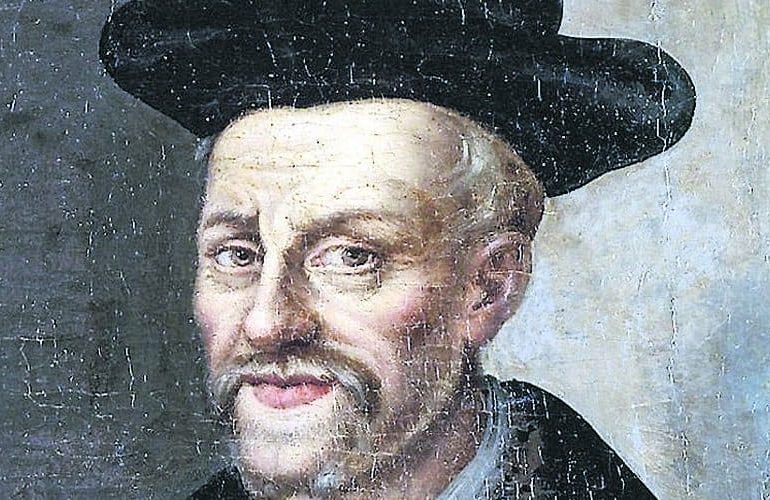Francois Rabelais was probably born in Chinon, in La Devinière, an estate located in the Touraine region of France, on a date between 1484 and 1494. The most probable date, commonly accepted, is February 4, 1494. However, beyond biographical uncertainties, his merits as a satirical, comic, ironic and grotesque writer, author of the famous saga of Pantagruel and Gargantua, the two giants of French folklore, are certain.
A prominent and controversial figure of the Renaissance, Rabelais is also considered one of the most influential anti-classists. Licentious monk with a strong personality, often in conflict with the official clergy, and also a doctor, he remained a great figure of the Renaissance humanist, convinced and of great culture, he was also an expert in ancient Greek.
He was born into a wealthy family, his father, the lawyer Antoine Rabelais, was Seneschal of Lerne. According to the historians of the time, around 1510 the writer would have entered the Franciscan monastery of La Baumette, erected off the coast of Maine, in the Chanzé Angers castle, where he immediately began to devote himself to purely theological studies. Some give him as a pupil at Seuilly Abbey, but there is no confirmation. He was appointed a Franciscan friar at the Puy Saint-Martin convent in Fontenay-le-Comte, where he moved to complete his extensive cultural and theological training between October 1520 and 1521.
In that period, both within the religious institution and outside of it, Rabelais was known for his great intellectual gifts, considered by many to be an academic and learned humanist. With the well-known philologist Guillaume Budé, he maintained in those years a correspondence of great intellectual depth, where one can see the in-depth study of Latin and, above all, Greek. Just in that language, the friar stood out and gave evidence in his translations of some of the most important Greek works, from the “History” of Herodotus to the philosophical writings of Galen, which he carried out a few years later.
His fiery personality led him to write and comment on some works in an unorthodox way, thus being suspected of heretical tendencies. He was incriminated by the Greek texts that he had in his library, as a result of the prohibition imposed by the Sorbonne to own books in the Greek language. The Franciscan order used the excuse and ordered the kidnapping of him. However, Francois Rabelais managed to escape thanks to the protection he enjoyed by Bishop Geoffroy d’Estissac, who wanted him as his personal secretary, helping him to go from the Franciscan to the Benedictine order.
The monk began to accompany the bishop on his inspection trips to various French convents. He was staying at the priory of Ligugé, the usual residence of Geoffroy d’Estissac, he met Jean Bouchet, becoming his friend, and passing through the monastery of Fontenay-le-Comte, he met the noble abbot Antoine Ardillon. He traveled through many provinces of France, and remaining anonymous, he attended some universities, such as Bordeaux, Toulouse, d’Orléans and Paris. Around 1527 Rabelais attended the University of Poitiers where he took law courses. However, he did not support the monastic rules and in 1528 he left the robes.
He passed through the French capital, joined a widow, with whom he would have had two children, and after having begun to study medicine, he decided to enroll on September 17, 1530, at the Faculty of Medicine of Montpellier. There, the doctor, philologist and former monk, learned the teachings of Hippocrates and Galen, two of his favorite authors, and in a year he skillfully passed high school, becoming a doctor.
From 1532 he practiced as a doctor at the Hôtel-Dieu de Lyon, center of the French Renaissance. There the environment was ideal for the monk’s literary talent to finally emerge. In the meantime, he joined some important personalities and continued his scientific publications. That same year came the publication of the first volume of the series that bears his name, which focused on the two bizarre giants drawn from French folklore, Pantagruel and Gargantua. Francois Rabelais created “Pantagruel”, in 1532, under the pseudonym Alcofribas Nasier (an anagram of his name). At the same time, he wrote a letter to Erasmus of Rotterdam, in which he declared that all his humanist offspring came from a passion for the philosopher and for his great thoughts. He declared in the letter his will to have tried to reconcile pagan thought with Christian, giving life to the so-called Christian humanism.
The Sorbonne, true autocratic law of French academicism, blocked and tried to prevent his publications, all of them related to his pseudonym, now known not only in Lyon. With this signature Rabelais also published “Gargantua” in 1534, which completely takes up the protagonist hero of the French saga, also narrated verbally by the chansonniers of France. His previous book, the one linked to Pantagruel, tells the story of the probable son of the historical protagonist of the saga.
The French author resumed his institutional travels and settled in Rome, accompanied by Jean du Bellay, his protector, in the house of Pope Clement VII. His mentor became a cardinal and was acquitted of the crimes of apostasy and irregularities with which he was accused, together with a large group of prelates of the French clergy, as a result of the operation des Placards, dated 1534, and in connection with a series of communications in open conflict in relation to the Roman clergy.
For the next several years, the former monk was still in Rome, this time with his former patron, Geoffroy d’Estissac. From this moment on, his return to papal grace began, as evidenced by a letter dated January 17, 1536, sent by Paul III, which included authorization for Rabelais to practice medicine in any Benedictine monastery, as long as no surgery was done. The French writer chose the monastery of Cardinal du Bellay, in Saint-Maur-des-Fosses.
In 1540, François and Junie, Rabelais’s illegitimate children during his stay in Paris, were legitimized by Pope Paul III. Having obtained the royal privilege for printing the previous year, in 1546 the former public friar, signing with his real name, the so-called “Third Book”, which takes up the previous two in their entirety, uniting their two heroes, in a choral saga The following year he retired to Metz, being appointed city doctor.
In July 1547 Rabelais returned to Paris, again in the wake of Cardinal du Bellay. A year later eleven chapters of the “Fourth Book” of the saga came out, before the publication of the complete version, in 1552.
On January 18, 1551, du Bellay granted Rabelais the parish of Meudon and Saint-Christophe-du-Jambet. However, after two years of official activities, it is not known whether or not the writer has fulfilled his priestly duties. Theologians, however, after the publication of the “Fourth Book”, censored it without appeal. On January 7, 1553, therefore, the author resigned as a priest. Francois Rabelais died in Paris shortly after, on April 9, 1553.
In 1562 “Isla Sonnante” was published, which would include some of the chapters of the alleged “Fifth Book” of the ex-monk. However, even after the complete publication of the work, there are many linguists who have questioned its authenticity. However, they recognize as autographs some minor works, such as the so-called burlesque prophecy “Pantagrueline Prognostication” and “Sciomachia”, a report made to celebrate the birth of a son of King Henry II.
What was Rabelais known for?
Rabelais’ most famous works are the Gargantua-Pantagruel series, four books published from 1532 to 1535. Framed as chivalric romances, they use the theatrical language of vaudeville to satirize heroic works, traditional pedagogy, and humanist ideals.
What did Francois Rabelais contribute to the renaissance?
François Rabelais (c. 1494 – April 9, 1553) was a major French Renaissance writer, doctor, and humanist. He is regarded as an avant-garde writer of fantasy, satire, the grotesque, dirty jokes, bawdy songs, and anarchism. His work was highly original, in both subject matter and quality.
What were Francois Rabelais last words?
“I go to seek the Great Perhaps” are the reputed last words of French writer Francois Rabelais who died in 1553.
What did Rabelais say?
“Science without conscience is the soul’s perdition.” “Gestures, in love, are incomparably more attractive, effective and valuable than words.” “Tell the truth and shame the devil.” “A mother-in-law dies only when another devil is needed in hell.”
Why did Rabelais write Gargantua?
In his book Gargantua and Pantagruel, Francois Rabelais uses satire to address the dislocation felt by Renaissance Humanists. By providing an exaggerated fable, comical in nature, Rabelais poses a serious introspection into the extremes of both the Medieval and the Renaissance man.
Where did François Rabelais live?
Centre-Loire Valley
When and where was Francois Rabelais born?
Chinon, France





